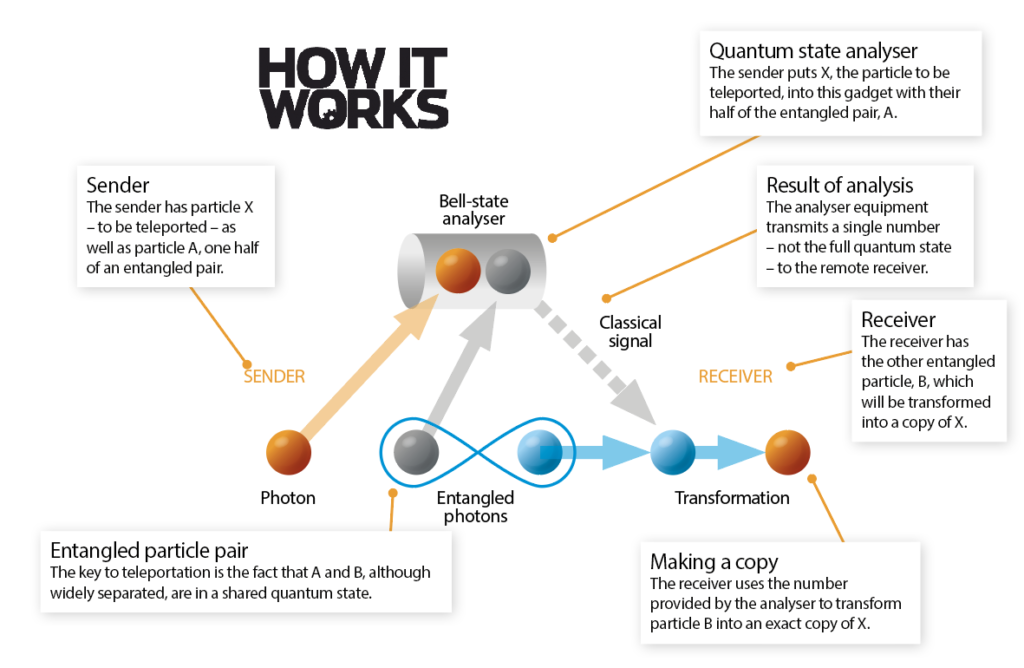Everything you need to know about teleportation in the real world
by Scott Dutfield · 02/02/2021
The strange phenomenon of quantum entanglement allows scientists to make exact copies of subatomic particles

Teleportation is a concept that’s familiar to most people, thanks to the fictional ‘transporter’ in Star Trek. As its name suggests, the latter is portrayed simply as another form of transport, getting a person from A to B as quickly as possible. But if you think about it, something much weirder is going on. When someone steps onto the transporter pad, they’re completely disintegrated – they cease to exist – and what appears at a remote location isn’t the original person, but an exact copy of them. When real-world scientists use the word teleportation, they’re just as interested in this copying side of the process as the transport one.
In the everyday world, making a passable copy of an object isn’t too difficult. But on the scale of subatomic particles – which is what we’re ultimately all made of – things are much harder. This is the world of quantum physics, and pinning down the exact ‘quantum state’ of a particle is notoriously difficult. The mere act of observing it alters it in an unpredictable way. It’s impossible, in fact, to make an accurate measurement of all of a quantum particle’s properties. But around 20 years ago scientists discovered that, without even looking at a particle, it’s possible to transfer its properties to another particle. That’s what they mean by ‘quantum teleportation’.
The secret lies in a strange-sounding quantum effect called ‘entanglement’, by which two separate particles can share a single quantum state – not in the sense that they’re both the same, but that knowing something about one tells you something about the other. Their properties are quite literally entangled. In quantum teleportation, the particle to be teleported is brought into contact with one half of a pair of entangled particles. The sender then tells the receiver, who has the other half of the entangled pair – even though they may be on the other side of the world – the result of a simple measurement. This allows the receiver to put their particle into an exact duplicate of the original particle’s state – which, as in a Star Trek transporter, no longer exists at the sending end.
It may sound like an abstract academic exercise, but quantum teleportation offers enormous practical benefits – not as a revolutionary means of transport, like its sci-fi predecessor, but in the world of quantum computing and quantum communications.
Teleporting humans
Despite its much smaller scale, quantum teleportation basically functions like a Star Trek transporter. It creates a copy of a particle at a distant location, and erases the original particle’s state. Human beings are just large collections of particles, so in theory it should be possible to teleport them too. But there are insurmountable difficulties. The number of particles involved is over 4 tredecillion – four with 42 zeros after it. There’s no way to handle that amount of data, quite apart from the technical challenge of creating all those entangled pairs of particles. Even if it was physically possible, the philosopher Derek Parfit has argued that a teleported copy wouldn’t be the same as the original person.
How quantum teleportation works
An exact copy of the particle being teleported appears at the receiving end
Why is teleportation important?
At first sight, being able to copy the quantum state of a particle may not look exciting – but it’s hugely significant for the viability of quantum computers. In place of electronic components that are always in one of two states, representing binary digits zero or one, these employ quantum particles that can be in any superposition of these states. The result, called a ‘qubit’, makes quantum computing much more efficient at number-crunching tasks like code-breaking and equation-solving.
There’s a catch though. Qubits, like all quantum states, are destroyed by any attempt to measure them. It’s here that teleportation comes to the rescue, by allowing information to be extracted – and even transmitted to distant locations – without disturbing the system. It’s an intrinsically secure process, too – because once again you can’t observe a quantum particle without changing its state. Trying to eavesdrop on a ‘teleported’ communication will destroy the message.
This article was originally published in How It Works issue 133, written by Andrew May
For more science and technology articles, pick up the latest copy of How It Works from all good retailers or from our website now. If you have a tablet or smartphone, you can also download the digital version onto your iOS or Android device. To make sure you never miss an issue of How It Works magazine, subscribe today!






